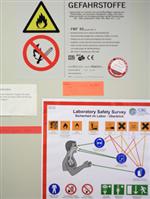Team:BIOTEC Dresden/Safety
From 2010.igem.org
| Line 25: | Line 25: | ||
<div id="content_prim"> | <div id="content_prim"> | ||
<h2>Safety</h2> | <h2>Safety</h2> | ||
| - | <a href="/wiki/images/a/af/BiotecDresden_Safety1_l.jpg" rel="lightbox"><img src="/wiki/images/b/b7/BiotecDresden_Safety1_s.jpg" class="border | + | <a href="/wiki/images/a/af/BiotecDresden_Safety1_l.jpg" rel="lightbox"><img src="/wiki/images/b/b7/BiotecDresden_Safety1_s.jpg" class="border left"></a> |
| - | + | ||
| - | + | ||
| - | + | ||
<p>All the members of the iGEM BIOTEC team participated in mandatory safety briefing concerning the good laboratory practices and the disposal of the biological, organic-chemical and EtBr waste by the institutional safety officer prior to the beginning of project at The Max Planck Institute of Molecular Cell Biology and Genetics, Dresden .</p> | <p>All the members of the iGEM BIOTEC team participated in mandatory safety briefing concerning the good laboratory practices and the disposal of the biological, organic-chemical and EtBr waste by the institutional safety officer prior to the beginning of project at The Max Planck Institute of Molecular Cell Biology and Genetics, Dresden .</p> | ||
<p>As working with natural or recombinant biological materials was inevitable part of our experiments, the Biosafety facility of The Max Planck Institute of Molecular Cell Biology and Genetics, Dresden was closely monitoring all of our research activities and took great care to ensure that all procedures carried out in the lab are in accordance with guidelines of Central Commission for Biological Safety, Germany (Zentrale Kommission für die Biologische Sicherheit).</p> | <p>As working with natural or recombinant biological materials was inevitable part of our experiments, the Biosafety facility of The Max Planck Institute of Molecular Cell Biology and Genetics, Dresden was closely monitoring all of our research activities and took great care to ensure that all procedures carried out in the lab are in accordance with guidelines of Central Commission for Biological Safety, Germany (Zentrale Kommission für die Biologische Sicherheit).</p> | ||
| + | <a href="/wiki/images/e/e3/BiotecDresden_Safety2_l.jpg" rel="lightbox"><img src="/wiki/images/b/bd/BiotecDresden_Safety2_s.jpg" class="border right"></a> | ||
| + | |||
<p>SensorBricks mainly consists of parts and plasmid constructions with simple genetic modifications. The E.coli strain-DH5 alpha was the standard laboratory strain without any health risks and potential pathogenicity. There were no intentional or accidental releases of any reagents that will pose biosafety threats to the environment, individuals of the project or the general public. </p> | <p>SensorBricks mainly consists of parts and plasmid constructions with simple genetic modifications. The E.coli strain-DH5 alpha was the standard laboratory strain without any health risks and potential pathogenicity. There were no intentional or accidental releases of any reagents that will pose biosafety threats to the environment, individuals of the project or the general public. </p> | ||
<p>None of our biobricks parts code for hazardous molecules. The transformed bacteria and constructed plasmids are limited to laboratory uses only. They are strictly considered as S1 waste and treated by the waste management facility appropriately. | <p>None of our biobricks parts code for hazardous molecules. The transformed bacteria and constructed plasmids are limited to laboratory uses only. They are strictly considered as S1 waste and treated by the waste management facility appropriately. | ||
| + | <a href="/wiki/images/e/eb/BiotecDresden_Safety3_l.jpg" rel="lightbox"><img src="/wiki/images/f/f2/BiotecDresden_Safety3_s.jpg" class="border left"></a> | ||
</p> | </p> | ||
</div> | </div> | ||
Revision as of 14:03, 26 October 2010

Safety

All the members of the iGEM BIOTEC team participated in mandatory safety briefing concerning the good laboratory practices and the disposal of the biological, organic-chemical and EtBr waste by the institutional safety officer prior to the beginning of project at The Max Planck Institute of Molecular Cell Biology and Genetics, Dresden .
As working with natural or recombinant biological materials was inevitable part of our experiments, the Biosafety facility of The Max Planck Institute of Molecular Cell Biology and Genetics, Dresden was closely monitoring all of our research activities and took great care to ensure that all procedures carried out in the lab are in accordance with guidelines of Central Commission for Biological Safety, Germany (Zentrale Kommission für die Biologische Sicherheit).

SensorBricks mainly consists of parts and plasmid constructions with simple genetic modifications. The E.coli strain-DH5 alpha was the standard laboratory strain without any health risks and potential pathogenicity. There were no intentional or accidental releases of any reagents that will pose biosafety threats to the environment, individuals of the project or the general public.
None of our biobricks parts code for hazardous molecules. The transformed bacteria and constructed plasmids are limited to laboratory uses only. They are strictly considered as S1 waste and treated by the waste management facility appropriately.

 "
"
